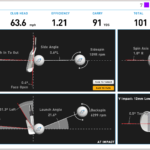Rule 12 – Searching For And Identifying Ball
 We’ve all hit a golf ball that we had to search for at one point or another. I have listed out some situations and how to proceed under the rules in those situations – so you’re not penalized two strokes under Rule 12.
We’ve all hit a golf ball that we had to search for at one point or another. I have listed out some situations and how to proceed under the rules in those situations – so you’re not penalized two strokes under Rule 12.
A player is not necessarily entitled to see his ball when making a stroke.
In searching for his ball anywhere on the course, the player may touch or bend long grass, rushes, bushes, whins, heather or the like, but only to the extent necessary to find or identify the ball, provided that this does not improve the lie of the ball, the area of his intended stance or swing or his line of play; if the ball is moved, Rule 18-2a applies except as provided in clauses a – d of this Rule.
In addition to the methods of searching for and identifying a ball that are otherwise permitted by the Rules, the player may also search for and identify a ball under Rule 12-1 as follows:
a. Searching for or Identifying Ball Covered by Sand
If the player’s ball lying anywhere on the course is believed to be covered by sand, to the extent that he cannot find or identify it, he may, without penalty, touch or move the sand in order to find or identify the ball. If the ball is found, and identified as his, the player must re-create the lie as nearly as possible by replacing the sand. If the ball is moved during the touching or moving of sand while searching for or identifying the ball, there is no penalty; the ball must be replaced and the lie re-created.
In re-creating a lie under this Rule, the player is permitted to leave a small part of the ball visible.
b. Searching for or Identifying Ball Covered by Loose Impediments in Hazard
In a hazard, if the player’s ball is believed to be covered by loose impediments to the extent that he cannot find or identify it, he may, without penalty, touch or move loose impediments in order to find or identify the ball. If the ball is found or identified as his, the player must replace the loose impediments. If the ball is moved during the touching or moving of loose impediments while searching for or identifying the ball, Rule 18-2a applies; if the ball is moved during the replacement of the loose impediments, there is no penalty and the ball must be replaced.
If the ball was entirely covered by loose impediments, the player must re-cover the ball but is permitted to leave a small part of the ball visible.
c. Searching for Ball in Water in Water Hazard
If a ball is believed to be lying in water in a water hazard, the player may, without penalty, probe for it with a club or otherwise. If the ball in water is accidentally moved while probing, there is no penalty; the ball must be replaced, unless the player elects to proceed under Rule 26-1. If the moved ball was not lying in water or the ball was accidentally moved by the player other than while probing, Rule 18-2a applies.
d. Searching for Ball Within Obstruction or Abnormal Ground Condition
If a ball lying in or on an obstruction or in an abnormal ground condition is accidentally moved during search, there is no penalty; the ball must be replaced unless the player elects to proceed under Rule 24-1b, 24-2b or 25-1b as applicable. If the player replaces the ball, he may still proceed under one of those Rules, if applicable.









